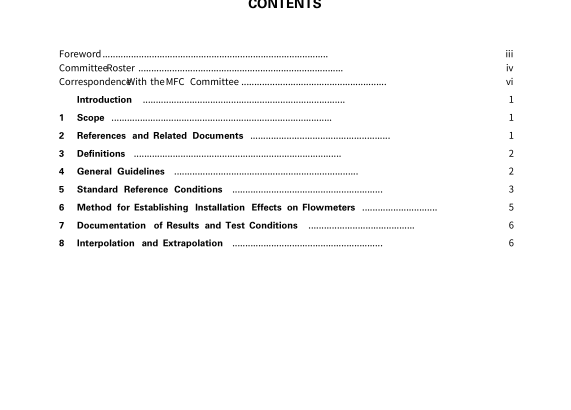ASME MFC-10M-2000 pdf free download.ASME MFC COMMITTEE MFC Measurement of Fluid Flow in Closed Conduits
5 STANDARD REFERENCE CONDITIONS
5.1 Description
The process of establishinginstallationeffects in‑ volves the comparisonof the performanceto thatob‑ tainedin a standardreferencecondition.This document allows for two standardreferenceconditions.One is basedon having specific, well‑defined flow patternsin the test installation(Basic Reference Condition), and the other is based on the constancy of flowmeter performancealong the pipe (Working ReferenceCondition).
5.1.1 Basic Reference Condition. The BasicReferenceConditionexists when the fluid velocity pattern at the flowmeteris identicalto thatwhich would exist if the meterwere installed in a conduitrunning full and steadywith unlimitedlengthsof straightupstream and downstreampipe. Such a flow patternis characterized by zero time‑averagedradial and azimuthalfluid velocitycomponents andan axisymmetricaxial velocity profile that is independentof axial position. These components canbeconsideredtobezeroif theiraverage values are zero to within the measurement uncertainty or if theyarenegligibleto within 0.01% of theaverage flow velocity.
The exactaxial velocity profile depends on the inner wall roughnessof the pipe (see ASME B46.1‑1985) and the Reynolds numberof the flow. The above flow pattern which defines the Basic Reference Condition is often describedas one which is steady,free from swirl, andhavinga fully‑developed axial velocity profile. 5.1.2 Working Reference Condition. From a practicalstandpoint, theachievement and/orverification of Basic ReferenceConditionsmay be limited by the test flow facility and/orinstrumentation. When such limitationsexist, a working referenceshouldbe established. The methodfor establishingthe existence of this referenceconditionis markedlydifferentfrom that for the Basic Reference Condition. Here flowmeter performanceratherthana specific flow patternis used as the criterion. Specifically, the Working Reference Conditionis achievedwhentheflowmeterperformance is independent of orientationand axial locationof the flowmeteralong the pipe.
NOTE: Ideally, theflowmeterperformanceachievedundertheWorking Reference Condition will not differ from that which would be observed if the flowmeter were installed in a Basic Reference Condition. This is so even though the flow patternspresentin the working referencecondition may in some cases differ from those in the Basic Reference Condition.
The explanationfor this lies in the fact thatdifferentflowmetershave differentsensitivitiesto flow patterns.As a consequenceof this differing sensitivity, the lengths of straightupstreamand downstreampiping requiredto achieve the Working ReferenceCondition will dependon the type of flowmeter being tested, as well as the test installation.A flowmeterthat is fairly insensitive to flow pattern will require only short straight lengths of adjacentpiping.
5.2 Experimental Methods for Establishing Standard Reference Conditions There are two ways to establishreferenceconditions in this Standard.They are describedin the following subparagraphs. The first of theseis more fundamental while the secondis more practicaland perhapseasier to accomplishin most circumstances.
5.2.1 Establishing a Basic Reference Condi- tion. Fora givenflowfacility,minimumstraightlengths of pipe upstreamand downstreamof the meterare to be determinedsuch that for an installation change beyond those minimum lengths of pipe, the timeaveragedradialandazimuthalfluid velocitycomponents are zero and the axial velocity profile remains unchanged.By comparingthis unchangingaxial, velocity profile with thosein theliterature(seeworksby Schlicting, Pao, Coles, Hines, Tennekes, Bogue, and Fluid Meters, in Section 2), the effective inner pipe wall roughnesscan be determined.On the other hand, if thepiperoughnessis alreadyknown,theexistenceof a fully‑developedaxial velocityprofile can be established directlyby comparingthe measuredprofile with those in the literature. Measurementsof the local fluid velocity can be carried out using standardtechniquessuch as pitot tubes,hotwire or hotfilm anemometers, laserDoppler velocimeters,etc. (See, for example, ISO 3966, ISO 7194, ASME PTC 11, and similar references.)
A Basic ReferenceConditioncan be establishedby following the steps outlined below. If necessary, a limited testprogramis permitted,providedthatall of the limitationsare documented.
Step 1. Using calibrationprocedures, establishthat the velocity measurementinstrumentation is operatingproperlyandquantifyits uncertainty.
Step 2. Install the velocity measurement probein the pipe with any convenientupstream straightpipe length,but with at leastfour pipediameterlengthsofstraightpipedownstreamof the probe.
Step 3. If instrumentationallows, measure at a nominalflow ratethe radialand azimuthal velocity componentsat ten or more locations in the crosssectionalplane. If the time‑averagedvaluesat any given location are not equalto zero within the measurement uncertainty, then Basic Reference Conditionsdo not exist. In this case, pro‑ ceed to Step 6.ASME MFC-10M pdf download.ASME MFC-10M-2000 pdf free download
